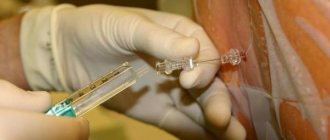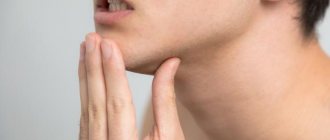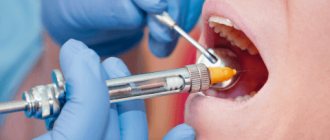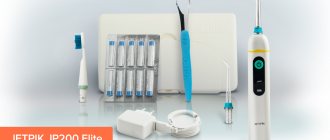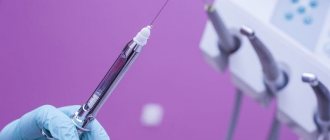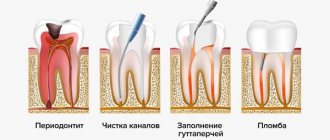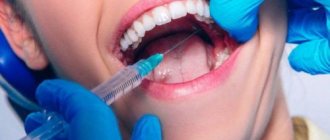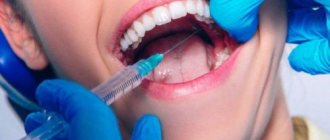Nowadays, with many safe anesthetic drugs available, the use of general anesthesia for dental treatment or extraction may seem excessive. However, it allows you to carry out any procedure - treatment, tooth extraction, restoration of fillings or sanitation of the oral cavity - completely painlessly. Many people still choose to have teeth removed under general anesthesia. Be that as it may, the choice of anesthesia method remains with the patient; the doctor’s duty in this case is to give the patient information about the advantages and consequences of each method.
Types of combined anesthesia
- Neuroleptanelgesia. The method involves a combination of antipsychotic and narcotic drugs. In this case, antipsychotics have an inhibitory effect on the nervous system, and narcotic substances enhance the analgesic effect. The drugs most often used are: etapyrazine, aminazine, droperidol and haloperidol;
- Intubation anesthesia. The substance enters the respiratory system using a laryngeal mask. Due to its complexity, this method is also not used often.
Ataralgesia. The combination of analgesics and tranquilizers gives a calming, relaxing and analgesic effect. The most commonly used tranquilizer components are: Relanium, Elenium, Phenazepam and Grandaxin.
Types of sedation in dentistry
There are quite a few ways to administer relaxing drugs, but only a few of them are used in dental clinics:
- Inhalation
. The most common mind control technique. The advantages of dental treatment under sedation through inhalation: quick effect, the process is easy to control, consciousness is restored in a very short period of time. The most common use is nitrous oxide. It has a relaxing effect, reduces motor activity and has some analgesic properties. Subject to the rules of supply and percentage of gases, there are practically no side effects. - Injection
. The drug is administered once, as an injection or gradually, through an intravenous infusion system. The most well-known drugs are profopol and medazolam. Their hypnotic effect allows dental treatment to be performed while you sleep, while maintaining basic reflexes and spontaneous breathing. Recently, dexmedetomidine has been increasingly used because it does not lower blood pressure. - Oral medication
. If the patient is afraid of the needle, but calmly takes the pills, they can be used. - Intranasal dispersion
. An anesthetic is sprayed into the nasal passages. So the drug, through the taste buds, immediately enters the brain. Quick effect, bioavailability, central action and ease of use make sprays very popular.
Introduction of anesthesia: step-by-step description
- Introduction to a state of anesthesia.
- Analgesia. The duration of the stage is approximately 4-5 minutes. At this time, the patient's pain sensitivity decreases, but all reflexes and stable body temperature are preserved.
- Excitation. The duration of the stage is 7 minutes. During this period, the following are observed: instability of pulse and temperature, increased salivation and muscle tone.
- Maintaining anesthesia. This stage is conditionally divided into several stages-levels:
- Surface. The following are noted: normalization of pulse and pressure, muscle tone with complete blocking of sensitivity;
- Easy. Characterized by rhythmic breathing and muscle relaxation. At this point, the doctor can already begin initial, superficial manipulations;
- Full anesthesia. There is complete relaxation of the muscles, rhythmicity of the pulse and breathing, and a slight decrease in blood pressure;
- Ultra-deep anesthesia. Characterized by shallow breathing, weak pulse and low blood pressure.
After completing the manipulations, the supply of the anesthetic substance is stopped and it is replaced with pure oxygen for 2-3 minutes. It is during this interval that the patient awakens, and after 30 minutes his complete recovery is observed.
What you need to know about anesthesia for dental treatment
10-30% of people do not go to the dentist because of pain. Delaying treatment makes the problem worse. Pain management helps patients feel comfortable during dental procedures.
Types of dental anesthetics
Anesthesia means absence or loss of sensation. With light anesthesia, the person is conscious. In severe cases, the patient is put to sleep. The doctor at the Nika Dentistry clinic uses medications separately or in combination. Selects medications for a safe procedure. The type of anesthetic used also depends on the person's age, health, length of the procedure, and previous negative reactions to anesthetics.
Short-term medications are applied directly to the tooth area. Long-acting is used when complex jaw surgery is performed.
The success of dental anesthesia depends on:
- drug;
- areas of anesthesia administration;
- type of procedure;
- time of the operation;
- severity of inflammation.
Local anesthesia in the lower jaw is not as strong as in the upper jaw.
Doctors give three types of anesthesia: local, sedative and general. The choice depends on the location of the manipulation, the severity of the problem and the combination with other medications.
Local anesthesia
Local anesthesia is used for simple procedures such as tooth filling, which require a short time to complete and are less complex. The person is conscious and talking when local anesthesia is given. The area is numb so that the patient does not feel pain. A popular local anesthetic is lidocaine.
Local anesthetics will numb the pain within 10 minutes, and the best anesthesia for dental treatment wears off between 30 and 60 minutes. Sometimes a vasopressor such as epinephrine is added to enhance the effect and prevent the anesthetic effect from spreading to other parts of the body.
Local anesthetics are available in the form of gel, ointment, cream, spray, patch, liquid and ampoules. Use topically (apply directly to the area to numb it) or inject into the area being treated.
Sometimes sedatives are added to anesthetics to help you relax. The patient remains fully conscious and responds to commands after slight sedation. If the drug is moderate, the person is semi-conscious or almost unconscious if the sedation is deep.
Sedatives are administered orally (tablet or liquid), inhaler, intramuscularly, or intravenously. During moderate to deep sedation, the doctor monitors your heart rate, blood pressure, and breathing.
General anesthesia
General anesthesia is used for long procedures or when the client is nervous and interferes with treatment. The person is unconscious, does not feel pain, the muscles are relaxed, and does not remember how the operation took place. The medicine is administered by putting a mask on the face or intravenously. The dose depends on the procedure and the patient's condition.
What are the side effects
The side effects of dental anesthesia depend on the type of anesthetic used. General anesthesia has more risks than local anesthesia. Reactions also vary:
- nausea or vomiting;
- headache;
- sweating or shaking;
- hallucinations, delusions, or confusion;
- slurred speech;
- dry mouth or throat;
- pain at the injection site;
- dizziness;
- fatigue;
- numbness;
- trismus caused by trauma from surgery.
Vasoconstrictors such as epinephrine added to anesthetics also cause heart and blood pressure problems. These are some side effects of anesthetics. Ask your dentist about the medicine and any problems that may arise after use.
Precautions when prescribing
A person gives consent to treatment before sitting in the dentist's chair. Ask your doctor questions about the risks and precautions to take for a positive outcome.
Pregnancy
The dentist or surgeon will discuss the risks and benefits of anesthetics for the expectant mother and fetus.
Special Needs
For children and people with special needs, the type and dose of anesthetic is adjusted to avoid adverse reactions or overdose.
Aged people
Seniors with health problems will require dosage adjustments and monitoring during and after surgery. Some people become delirious or experience confusion and memory problems after surgery.
Liver, kidney, lung, or heart problems
People with liver, kidney, lung, or heart disease require a dose adjustment because the medicine will take longer to leave the body or will have a strong effect.
Neurological diseases
If you have a history of stroke, Alzheimer's disease, Parkinson's disease, thyroid disease or mental illness, the risk of general anesthesia is increased.
Other conditions
Tell your dentist if you have a hiatal hernia, acid reflux, infections or open sores in your mouth, allergies, severe nausea and vomiting, or are taking medications that cause drowsiness.
The risks are higher for those who:
- sleep apnea;
- epilepsy;
- obesity;
- hypertension;
- heart problems;
- attention or behavior disorder;
- chronic obstructive pulmonary disease;
- gastric bypass;
- Substance abuse.
What are the risks of dental anesthesia
Most people do not experience adverse reactions with local anesthesia. There is a higher risk with general anesthesia, especially in older people and people with medical complications. There is an increased risk of abnormal bleeding while taking blood thinning medications such as aspirin. If you are taking painkillers or nerve medications, tell your dentist or surgeon so they can select an anesthetic.
Anesthesia risks:
- seizures;
- coma;
- respiratory arrest;
- heart failure;
- heart attack;
- stroke;
- hypotension;
- hyperthermia;
- muscle stiffness;
- breathing problems;
- tachycardia.
Allergic reaction
Tell your dentist about any allergies, including reactions to dyes or other substances: rash, itching, swelling of the tongue, lips, mouth, or throat, and difficulty breathing; The anesthetics articaine and prilocaine at a concentration of 4% damage nerves and cause paresthesia;
Conclusion
Discuss concerns about the procedure with your dentist. Ask questions about medications used for pain and what to expect during and after treatment. Get a medical history from your physician, including information about allergies and other medications you take, including over-the-counter and prescription medications and dietary supplements.
Ask for instructions on how to behave before and after, including eating and drinking before and after oral procedures. Ask if transportation home needs to be arranged and see if all questions have been asked of the dentist. The dentist will provide instructions to follow before and after the procedure, and will provide a phone number to contact them in case of complications or questions.
The main nuances and disadvantages of treatment under general anesthesia
There are a number of disadvantages in the question “ is it possible to treat teeth under general anesthesia ”:
- There is an increased load on the pulmonary and cardiovascular systems;
- Post-anesthesia symptoms are common: nausea, vomiting and weakness;
- Due to limited time, it is possible that the selection of filling material is insufficiently high-quality and the treatment process is disrupted, which consists in the impossibility of preserving the anatomical forms of the tooth being restored.
All manipulations when working with general anesthesia are carried out by: a dentist, a nurse and an anesthesiologist. Throughout the procedure, the operation of all vital systems is constantly monitored.
Consequences of sedation in dentistry
Specific problems with the use of mind control drugs depend on the route of administration and the mechanism of action of the drugs.
At the beginning of the procedure, you may experience increased activity, physical restlessness, talkativeness, and increased sociability.
A common symptom is an obsessive cough. This problem can be stopped by reducing the dose of the drug. Complications after sedation can appear both immediately and in a delayed period.
Possible short-term complications
- Breathing disorders (slow breathing, lack of oxygen);
- problems with hemodynamics (drop in blood pressure, irregular heart rhythm);
- depression of the central nervous system;
- intestinal dysfunction, vomiting.
Delayed symptoms
- Development of psychoses;
- hallucinatory syndrome;
- paralysis.
Is sedation dangerous? No, if it is carried out by an experienced doctor who has undergone special training, and the clinic is equipped with everything necessary to eliminate the consequences. But this is not a magic pill that can be prescribed to everyone without thinking about the consequences.
Premedications
- Sedatives of plant origin (Corvalol, tinctures of motherwort and valerian). Necessary to reduce excitability.
- Neuroleptics (droperidine).
- Anticholinergic drugs.
- Opioid drugs (promedol and morphine).
The selection of the listed drugs is made by the attending physician, based on the specific situation and individual characteristics of the small patient. There must be a compelling reason to use general anesthesia in children.
Cross allergic reactions between anesthetics:
- Among group I local anesthetics, intragroup cross-allergic reactions are often observed. In this case, drugs from the second group are prescribed. Exceptions: lidocaine - novocaine; lidocaine - benzocaine.
- They are also possible between group II drugs with a similar structure (lidocaine, prilocaine and mepivacaine).
- Until recently, it was believed that with intolerance to local anesthetics Group I
Group II
drugs can be used due to the absence of intergroup cross-reactions. However, there are reports of the possibility of developing allergic reactions, including anaphylactic reactions, to lidocaine (xicaine) with intolerance to novocaine, as well as to benzocaine (anesthesin) with intolerance to lidocaine.
It should be borne in mind that many side effects of local anesthetics, for example, swelling at the injection site, arterial hypotension, tachycardia, collapse, occur in both allergic and non-allergic reactions to these drugs. Allergic reactions when using local anesthetics are more likely to develop to additives
(bisulfite and parabenzoic acid, etc.) included in their composition.
Is it possible to remove teeth under general anesthesia?
Tooth extraction under general anesthesia requires compliance with all the previously listed measures and is carried out taking into account all individual nuances. Contraindications are given the greatest attention. If there is an excess of possible risks over the expected benefits, the use of general anesthesia is replaced by other measures.
Additives to anesthetics:
1) Vasoconstrictors
Vasoconstrictors - added to increase the effectiveness of local anesthesia, as well as to slow down the entry of anesthetics into the bloodstream.
Adrenalin
Adrenaline is used most often. A relatively safe dilution of adrenaline is a concentration of 1:200,000, which can only be achieved in capsule preparations.
Norepinephrine
Norepinephrine is used less frequently as a vasoconstrictor. Norepinephrine, unlike adrenaline, is less dangerous in patients with cardiac pathology (coronary heart disease), but the risk of developing a hypertensive crisis with concomitant hypertension is higher.
Used instead of adrenaline for thyrotoxicosis and diabetes. Contraindicated in glaucoma.
Filipressin (octapressin)
Filipressin is a synthetic drug that does not have a direct effect on the heart. The effect is associated with its direct effect on the smooth muscles of blood vessels. Contraindicated during pregnancy, because may cause myometrial contractions.
Undesirable systemic effects of vasoconstrictors:
- rise in blood pressure,
- tachycardia,
- heart rhythm disturbances,
- angina attacks,
- centralization of blood circulation,
- headache.
Risk group when using vasoconstrictors
: patients with glaucoma, thyrotoxicosis, diabetes mellitus; patients taking drugs rauwolfine, thyroid hormones, tricyclic antidepressants, antidepressants - MAO inhibitors.
2) Preservatives
Parabens
(methylparaben
–
methyl 4-hydroxybenzonate, ethylparaben)
Parahydroxybenzoic acid esters (parabens) are used as preservatives, which have antibacterial and antifungal effects.
It must be remembered that parabens are included in various cosmetics, creams, toothpastes and can provoke contact dermatitis, so there is a real danger of an allergy to the local anesthetic drug.
Para-aminobenzoic acid (PABA), which is a metabolite of novocaine, has a similar structure to parabens, which can cause cross-allergic reactions. Many drugs (sulfonamides, oral antidiabetic drugs, furosemide, etc.) are derivatives of PABA. Therefore, it is not advisable to use drugs containing parabens if you have a drug allergy to the listed medications.
The presence or absence of parabens in the local anesthetic drug is indicated by the manufacturer. Parabens can cause sensitization of the body and anaphylactic shock.
3) Stabilizers
Sulfites
(sodium or potassium disulfite) are used as vasoconstrictor stabilizers. Allergy to sulfites is most common in patients with bronchial asthma (frequency - about 5%), so you should be especially careful when treating such patients. Sulfites cause edema, urticaria, bronchospasm through irritant receptors, nervous and vagal reflexes.
Where can you cure caries painlessly?
Regardless of what teeth need to be treated, you need to pay special attention to finding an experienced specialist. At the same time, it is very important that he conducts the appointment in a well-equipped dental center.
These requirements are fully met by the Line of Smile clinic. We employ doctors with extensive experience. They have access to the most effective and safe painkillers, so when you contact us, you don’t need to think about whether it’s possible to treat your teeth without pain. We guarantee each of our clients comfortable service conditions.
